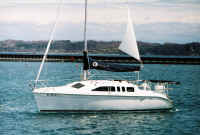Riding Sail

I've studied the sailboats in our harbor and have
observed some sail on the anchor more than others. The H260 seems
to swing more than most boats. Maybe it has something to do with
the freeboard? Unless my wife complains, I try to ignore this
situation.
Swinging on a mooring is an irritation and those
subject to seasickness can be affected. I've found attaching the
mooring pendent to the bow "U" bolt instead of the
forward cleats or rigging a bridle reduces swing somewhat.
Swinging at anchor is another matter. As the boat
hunts back and forth, exposure to the wind is increased thus
effecting its holding power. Many cruisers use a riding sail to
reduce swing. A riding sail lessens yawing by bringing windage
aft. Any sailmaker can make a riding sail or they can be
purchased. Google on "Sailrite
Riding Sail" or look into the innovative "FinDelta"
by Banner Bay. The riding sail should be tight and as far aft
as possible. Most boats attach the riding sail to the back stay
but since the H260 does not have a backstay I use the topping
lift.
Normally the riding sail is aligned with the boom
and boat centerline. Another option is to sheet the forward part
of the sail to one side so that the boat is actually sailing to
one side of the anchor rode. The boat should swing out until it
reaches an equilibrium between wind and topside windage. Locking
the rudder a few degrees to one side may also help keep the boat
pointed in the same direction.
Adding chain to the rode and/or lowering a “sentinel”
or “kellet” to increase the curve or centenary on the anchor
line is also an effective means of adding weight to the anchor and
reducing swing.